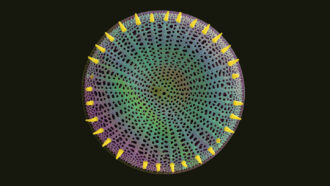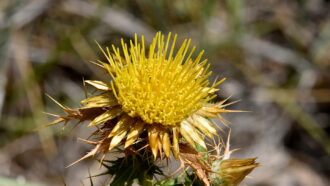Plants, animals adapt to city living
Urban life creates evolutionary changes in plants and animals, new research suggests
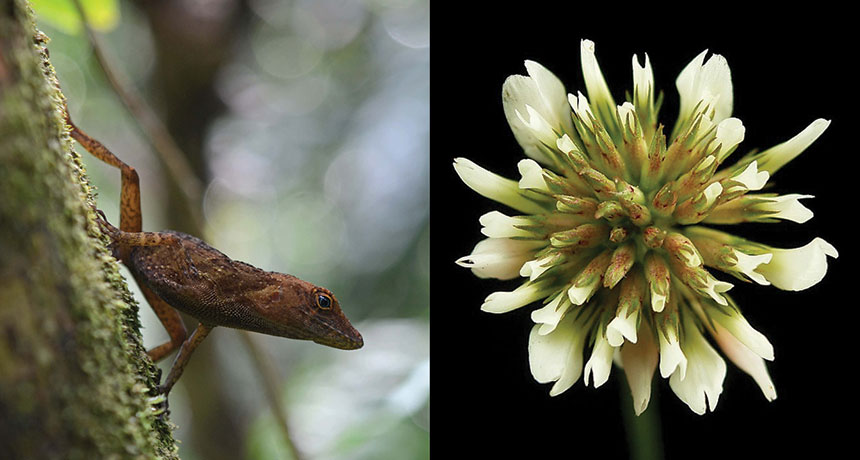
City life changes you. Just ask the tropical lizard Anolis cristatellus or the white clover, Trifolium repens. Both appear to have evolved biological traits to help them survive urban challenges, new research shows.
GEOFF GALLICE/WIKIMEDIA COMMONS (CC BY 2.0); FRANK VINCENT/WIKIMEDIA COMMONS (CC BY-SA 3.0 migrated)
By Susan Milius
AUSTIN, TEXAS — City life can change the basic physical traits of its residents, down to what plant leaves taste like or how sticky a lizard’s toes are. The findings show that cities have become unintended experiments in evolution. That’s the process through which species change over time in ways that make them better suited to where they’re living.
Researchers reported their new observations here at the 2016 Evolution conference.
Kenneth Thompson described how white clover (Trifolium repens) has adapted to urban living. Thompson is a graduate student at the University of Toronto Mississauga in Ontario, Canada. Leaf taste helps defend this clover against becoming lunch for grasshoppers and other predators, he noted on June 19.
Like all living things, the plant’s genes carry the instructions for building its tissues. And small differences in two of those genes let clover booby-trap its leaves and stem. Now, when bitten, it releases a warning burst of cyanide, a toxic chemical. A tiny, tiny taste of clover doesn’t kill animals. But its bitter taste can repel the spitting predator away so that it dines on some other plant.
Clover’s cyanide-making genes are more common in warmer locations. (That’s because ice harms clovers that carry these genes). And cities tend to be warmer than other areas. So Thompson expected to find more bitter clover in downtown Toronto than toward the outskirts. But he found just the opposite. That was startling because snails and other clover-eaters did about as much damage in both areas.
The same surprising pattern showed up in Boston, Mass., and New York City. But it didn’t occur in Montreal. The explanation, Thompson and his colleagues now propose, lies in what happens during winter.
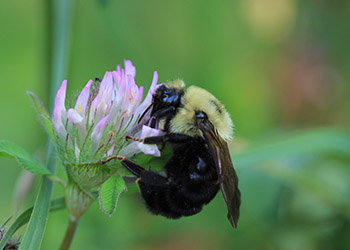
Winter cold is a special threat for cyanide-carrying clover. The reason has to do with how the plant makes the toxic chemical in its cells. Cyanide is toxic to plant tissue as well as to its predators. When the leaf doesn’t freeze, clover leaves and stems aren’t at risk. That’s because cells store the chemical ingredients for making cyanide separately. Those ingredients usually don’t mix until an animal bites the plant, crushing and ripping cells.
Such a defense damages some plant tissue. But that damage is worth the sacrifice because it can save the rest of the plant. Freezing, however, breaks apart the safety system and sets loose the cyanide on its maker.
Snow insulates plants from the cold. But in Toronto, Boston and New York, the buildup of heat in city centers means that the snow cover is thinner. That’s more true downtown than at the cities’ outer edges. And areas with thinner snow means clover hiding underneath are more likely to get cold enough for ice to burst their cells.
So the closer to city centers that a clover plant grows, the less likely it is to set up a cyanide defense. Doing so could mean the plant would poison itself during hard freezes, Thompson concludes. Montreal, though, has such heavy snow cover that even downtown clover can stay pretty well insulated.
The clover study highlights one opportunity for studying how plants adapt to city life. “It’s basically a replicated evolution experiment,” says Jason Munshi-South. He works at Fordham University in Armonk, N.Y. By replicated, he means that each city offers a new chance to test whether the same results occur elsewhere. Comparing cities “is where we need to go,” he says.
Leapin’ lizards
Urban evolution “is a very young field, growing very fast,” says Kristin Winchell. She, too, is a graduate student in biology. While she studies at the University of Massachusetts Boston, her field work focuses on an agile lizard in Puerto Rico.
Called Anolis cristatellus, these reptiles have colonized dense cities despite the perilous open stretches between trees. In urban areas, The lizard’s legs tend to be 2 to 5 percent longer than those of their forest cousins. It’s a finding that she and her colleagues reported in the May Evolution. And elaborate toe pads have more of the special scales that help these lizards skitter up walls.
On June 20, here, she presented her latest data on how this animal is adapting to city life.
Urban lizards may need all the advantages they can get to race around cities. The reason: They live in a more slippery environment. In the wild, the smoothest thing a lizard copes with is a leaf. They tend to be far rougher and easier to grip than a smooth metal surface.
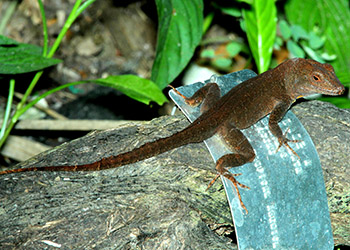
Winchell showed videos of lizards dashing up slanting lab racetracks. Some clearly had better footwork than others. In one clip, a lizard darts up the slippery unpainted aluminum surface — and pauses. Then it shoots to the end. It beat out a lizard that also stopped and then steadily slid backwards .The more sure-footed lizards tended to be the city dwellers.
Differences between city and country lizards show up even in a generation raised in the same environment, Winchell reported. That might mean the two groups of lizards have somewhat different genes. Or the animals’ genes may be the same, but how the animals’ bodies use them might differ. This is called gene expression. If so, mother lizards might pass along these differences to their offspring. Winchell still has to test these two possibilities.
She has a way to go before putting together the whole picture of how cities change lizards. But however these stories turn out, they have a special pull: The adaptations they reveal all happened during human existence. And as Munshi-South puts it, the evolutionary history of city life “is one we [people] created.”


